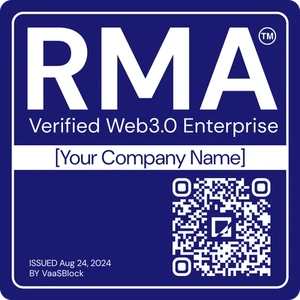
Mapprotocol
Risk Management
?Risk Management
The RMA™ is a blockchain credibility certification assessing governance, transparency, security, and results, providing trusted verification for businesses in Web3.
VaaSBlock has not audited this project and cannot vouch for this organization.
RMA™ Status: ❌ Unverified
Verification of 6 major compliance criteria.
Technology
?Technology
A collection of public facing information, data collected through partners and our own tools view we present a projects technology in one place for easy verification.
Analysis and testing of tech infrastructures.
Marketing
Alpha?Marketing
Top level look at a projects marketing capablities currently in alpha this section will grow to show quickly how a project promotes itself and the effectiveness.
Screening of user base and community feedback.
Background
?Background
Using multiple public facing sources across the web view a summary of a projects purpose, key achievements and general overview.
Collection of basic administrative documentation.
Risk Management
Last Updated
2025/4/16
Transparency
Transparency Score
Algorithmic assessment of a project’s transparency level, using multiple public data points to measure its commitment to compliance, documentation, and clarity in communication.
Transparency Score
Category Rank
A ranking that positions the organization among its industry peers, evaluating its relative performance based on key compliance, credibility, and transparency indicators.
Category Rank
Mapprotocol vs Layer-1
VaaSBlock Rank
A global ranking that compares the organization against all entities listed on VaaSBlock, reflecting its overall credibility, transparency, and operational performance versus the full Web3 ecosystem.
VaaSBlock Rank
Mapprotocol vs All Listed Organizations
Transparency
Transparency Score
Transparency Score
Algorithmic assessment of a project’s transparency level, using multiple public data points to measure its commitment to compliance, documentation, and clarity in communication.
Category Rank
Mapprotocol vs Layer-1
Category Rank
A ranking that positions the organization among its industry peers, evaluating its relative performance based on key compliance, credibility, and transparency indicators.
VaaSBlock Rank
Mapprotocol vs All Listed Organizations
VaaSBlock Rank
A global ranking that compares the organization against all entities listed on VaaSBlock, reflecting its overall credibility, transparency, and operational performance versus the full Web3 ecosystem.
RMA™
✘ UnverifiedCorporate Governance
The verification of fundamental governance, organizational structure, including verifying the entity’s legal registration and adherence to local laws and regulations.
Corporate
Governance

Team Proficency
Evaluation of an organization’s personnel, ensuring that crucial team members possess the expertise and dedication necessary to execute current business models and scale effectively.
Team
Proficiency

Technology & Security
Assessment of the organization’s technological framework, including blockchain integrations (where relevant), system architecture, and overall IT infrastructure.
Technology
& Security

Revenue Model
Comprehensively evaluation of a company’s income-generating strategies (how do they make or intend to make money), ensuring financial robustness and sustainability.
Revenue
Model

Results Delivered
The Results Delivered component of the RMA™ audit comprehensively evaluates an organization’s ability to achieve its goals and honor its commitments.
Results
Delivered

Planning & Transparency
The Planning and Transparency component of the RMA™ audit offers a thorough assessment of how an organization manages its workflow and prepares for unexpected challenges.
Planning &
Transparency

Technology
Marketing
Marketing Effectiveness
This score assesses the impact of detected marketing activity and the corresponding price movement of a token. The score understands whole market movements to ensure tokens are assessed fairly against peers.
Marketing Effectiveness
Confidence Index
This index determines our confidence in the score we have given. Generally, as more data is collected, the confidence index will increase. If a project has lots of activity, this confidence is earned faster.
Confidence Index
VaaSBlock Rank
This identifies where a project sits compared to all projects accessed for Marketing Effectiveness.
VaaSBlock Rank
Mapprotocol vs All Listed Organizations
Marketing Effectiveness
Marketing Effectiveness
This score assesses the impact of detected marketing activity and the corresponding price movement of a token. The score understands whole market movements to ensure tokens are assessed fairly against peers.
Confidence Index
Confidence Index
This index determines our confidence in the score we have given. Generally, as more data is collected, the confidence index will increase. If a project has lots of activity, this confidence is earned faster.
VaaSBlock Rank
Mapprotocol vs All Listed Organizations
VaaSBlock Rank
This identifies where a project sits compared to all projects accessed for Marketing Effectiveness.
No Chain No Gain™ Podcast ⛉
This Organization is yet to join the No Chain No Gain™ Podcast and share insights on what makes their business trustable and innovative.
💡 NCNG generated over 1 Million impressions in its first six months of existence.
PR Impact
PR Impact
VaaSBlock provides estimations to the impact that traditional digital media can have on a project. This is an early release; more areas of PR are planned in future versions.
Search Terms ? Search TermsThese are the terms we discovered the article for on page one of Google. | Est. Traffic ? Estimated TrafficWe estimate how much traffic an article will get. Generally, our estimations are slightly higher than those of more established tools. We are working on the algorithm all the time, and results could change. | Est. Value ? Estimated ValueBased on the estimated traffic we generate an estimation for what this traffic would have cost to generate if you tried to target these users with ads. The positions for the article on google and the location of the traffic are the major factors in this estimation. | |||
|---|---|---|---|---|---|
MAP Protocol source: github.com | MAP Protocol… — MAP Protocol source: github.com | Organic | github.com | ||
Map Protocol source: Coinbase | Map Protocol… — Map Protocol source: Coinbase | Organic | coinbase.com | ||
What is MAP Protocol? source: thebigwhale.io | What is MAP Protocol… — What is MAP Protocol? source: thebigwhale.io | Organic | thebigwhale.io | ||
Map Protocol Network | Bitcoin Layer 2 source: diadata.org | Map Protocol Network… Seen 2024-10-17T19:00:00.000Z Map Protocol Network | Bitcoin Layer 2 source: diadata.org | Organic | diadata.org |
| Est. Traffic | Est. Value | ||
|---|---|---|---|
MAP Protocol… — | |||
Map Protocol… — | |||
What is MAP Protocol… — | |||
Map Protocol Network… Seen 2024-10-17T19:00:00.000Z |
Background
Organization Name – Mapprotocol
Category – Layer-1
About
powered by irmaAI
irmaAIMAP Protocol is a decentralized, peer-to-peer cross-chain infrastructure designed to enable seamless interoperability between Bitcoin Layer 2 solutions and various blockchain ecosystems. Founded in 20…20 by James Cheng and headquartered in Singapore, the project aims to address the fragmentation in the blockchain space by providing a unified platform for asset transfer, data exchange, and application development across diverse networks.  
At its core, MAP Protocol operates as a Bitcoin Layer 2 solution, leveraging the security of the Bitcoin network to facilitate cross-chain interactions. The protocol employs a unique architecture that includes the MAP Relay Chain, a Proof-of-Stake (PoS) blockchain adopting the Istanbul Byzantine Fault Tolerant (iBFT) consensus mechanism. This relay chain serves as the backbone for cross-chain communication, enabling the verification and execution of transactions across connected networks. 
One of the key innovations of MAP Protocol is its use of light clients and zero-knowledge (ZK) proofs to achieve secure and efficient cross-chain verification. Light clients are deployed on each connected blockchain, allowing for the validation of cross-chain messages without relying on centralized intermediaries. The integration of ZK technology enhances the scalability and privacy of these interactions, ensuring that cross-chain operations are both secure and cost-effective.  
MAP Protocol’s infrastructure is designed to support a wide range of blockchain networks, including both Ethereum Virtual Machine (EVM) compatible chains and non-EVM chains. By embedding the signature algorithms and hashing functions of various blockchains into its virtual machine, MAP Protocol enables seamless communication between heterogeneous networks. This all-chain coverage ensures that developers can build applications that operate across multiple ecosystems without the need for complex bridging solutions.  
The protocol’s architecture is structured into three primary layers: the Protocol Layer, the MAP Omnichain Service (MOS) Layer, and the Application Layer. The Protocol Layer encompasses the MAP Relay Chain and the light clients responsible for cross-chain verification. The MOS Layer provides developers with tools and services, such as the Messenger Program and Vaults, to facilitate the development of omnichain applications. Finally, the Application Layer hosts decentralized applications (dApps) that leverage the underlying infrastructure to offer cross-chain functionalities to end-users.  
MAP Protocol’s native token, MAPO, plays a central role in the ecosystem. It is used for staking by validators, paying transaction fees, and participating in the governance of the protocol through the MAPDAO. The tokenomics are designed to incentivize active participation and ensure the security and sustainability of the network. 
Since its inception, MAP Protocol has achieved several significant milestones. In August 2022, the project launched its mainnet, marking the transition from development to a fully operational network. This launch was the culmination of four years of rigorous development and testing, including extensive code audits and the implementation of advanced cryptographic techniques.  
In April 2025, MAP Protocol underwent the MAI Hard Fork, introducing AI-powered gas optimization features to enhance the efficiency of cross-chain transactions. This upgrade demonstrated the protocol’s commitment to continuous improvement and its responsiveness to the evolving needs of the blockchain community. 
MAP Protocol has also established strategic partnerships to expand its reach and capabilities. Notably, in April 2025, the project announced a collaboration with China Unicom Global to pioneer AI innovation in the Web3 space. This partnership aims to integrate AI and blockchain technologies, fostering the development of intelligent, decentralized applications. 
The protocol’s commitment to decentralization and community involvement is evident through the establishment of the MAPDAO. This decentralized autonomous organization empowers stakeholders to participate in decision-making processes, propose protocol upgrades, and contribute to the overall governance of the network. By fostering an inclusive and participatory environment, MAP Protocol ensures that its development aligns with the interests and needs of its diverse user base. 
MAP Protocol’s approach to cross-chain interoperability addresses several challenges inherent in existing solutions. Traditional cross-chain bridges often rely on centralized intermediaries, introducing points of failure and potential security vulnerabilities. In contrast, MAP Protocol’s use of light clients and ZK proofs enables trustless, peer-to-peer interactions, enhancing the security and resilience of cross-chain operations.  
Furthermore, the protocol’s emphasis on supporting both EVM and non-EVM chains positions it as a versatile solution capable of bridging a wide array of blockchain networks. This inclusivity is critical in an increasingly fragmented blockchain landscape, where interoperability is essential for the seamless exchange of assets and information. 
MAP Protocol’s infrastructure also facilitates the development of a variety of decentralized applications. Developers can leverage the MOS Layer to build cross-chain dApps, such as decentralized exchanges, lending platforms, and NFT marketplaces. By providing comprehensive SDKs and APIs, MAP Protocol simplifies the development process, enabling creators to focus on delivering innovative solutions to users. 
The protocol’s design also accommodates the integration of emerging technologies. For instance, MAP Protocol supports the cross-chain transfer of BRC-20 tokens, enhancing the liquidity and utility of assets within the Bitcoin ecosystem. Additionally, the protocol’s infrastructure is conducive to the development of applications that incorporate artificial intelligence and Internet of Things (IoT) functionalities, broadening the scope of potential use cases. 
MAP Protocol’s vision extends beyond technical interoperability; it aspires to foster a truly decentralized and inclusive Web3 ecosystem. By enabling seamless interactions across diverse blockchain networks, the protocol aims to empower users with greater control over their digital assets and data. This commitment to user sovereignty aligns with the foundational principles of blockchain technology and underscores MAP Protocol’s role in shaping the future of decentralized applications.
In conclusion, MAP Protocol represents a significant advancement in the realm of blockchain interoperability. Through its innovative use of light clients, zero-knowledge proofs, and a robust multi-layered architecture, the protocol addresses critical challenges in cross-chain communication. Its commitment to decentralization, inclusivity, and continuous innovation positions MAP Protocol as a pivotal player in the ongoing evolution of the blockchain ecosystem.
Read More
Creation Date
December 2025
Headquarters
Singapore
Organization Maturity Level
Growing Business
RMA™ Type
–
Useful Links
Website – mapprotocol.io
Notable Achievements
2020
Project founded by James Cheng
2022
Mainnet launch with MAP Relay Chain
2023
Integration of ZK-LightClient technology
2024
Support for BRC-20 token cross-chain transfers
2025
MAI Hard Fork introducing AI-powered gas optimization
- vaasblock.com /
- Layer-1 /
- Mapprotocol











